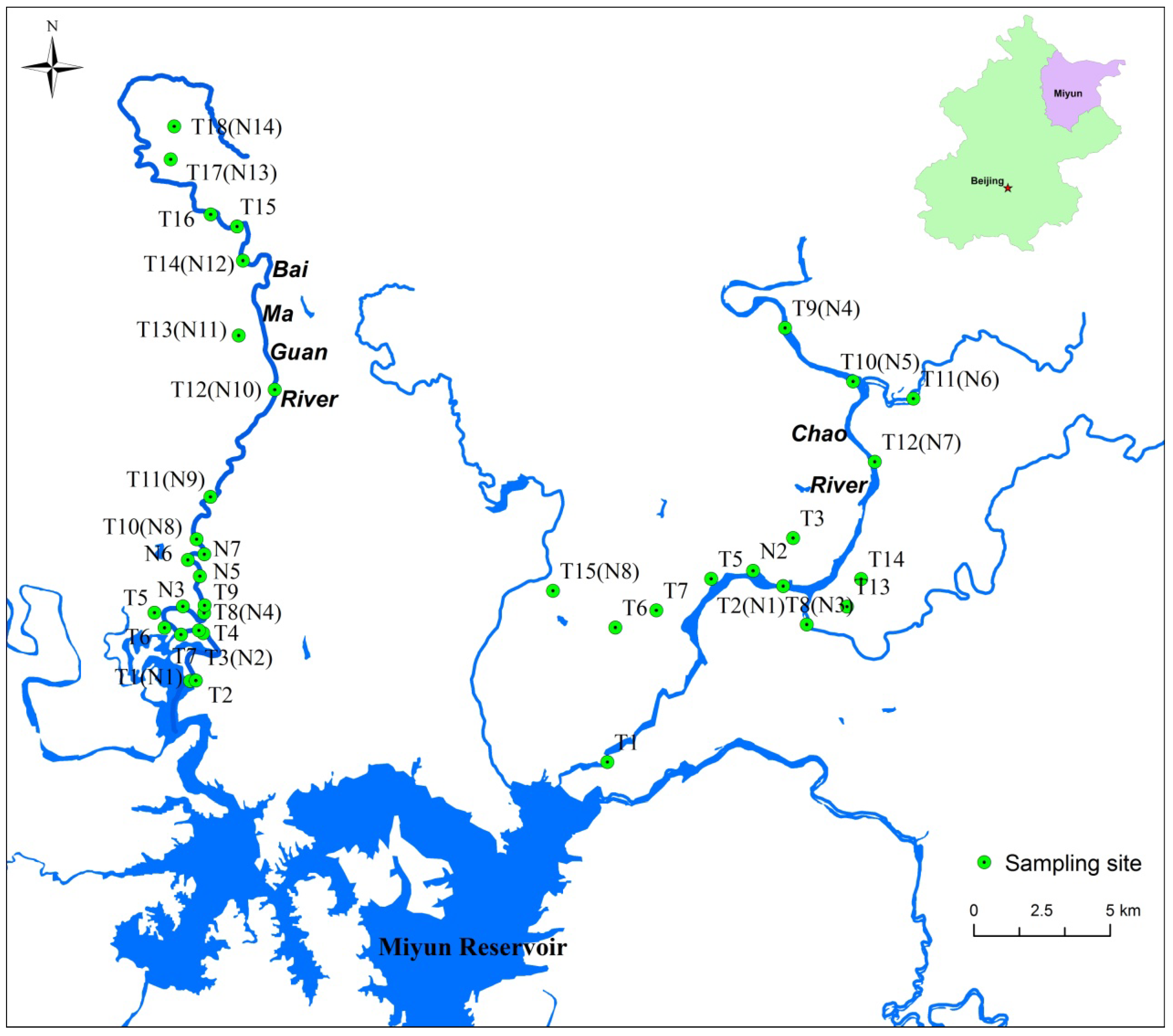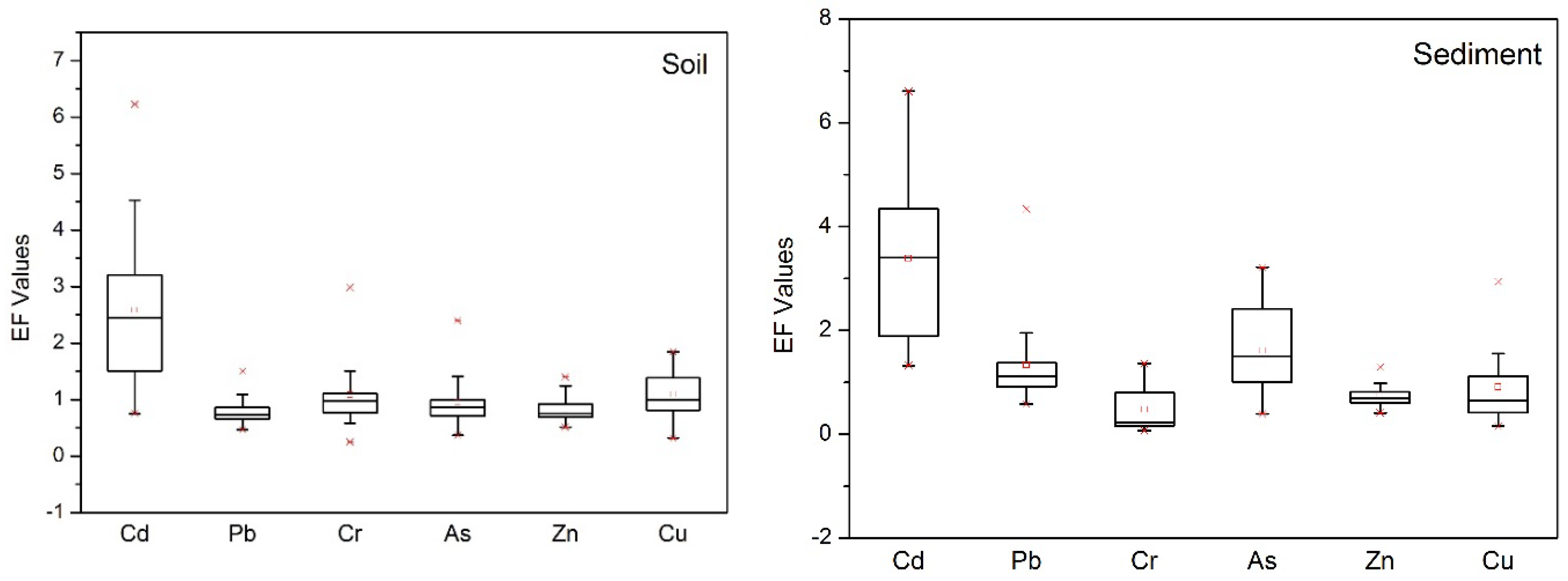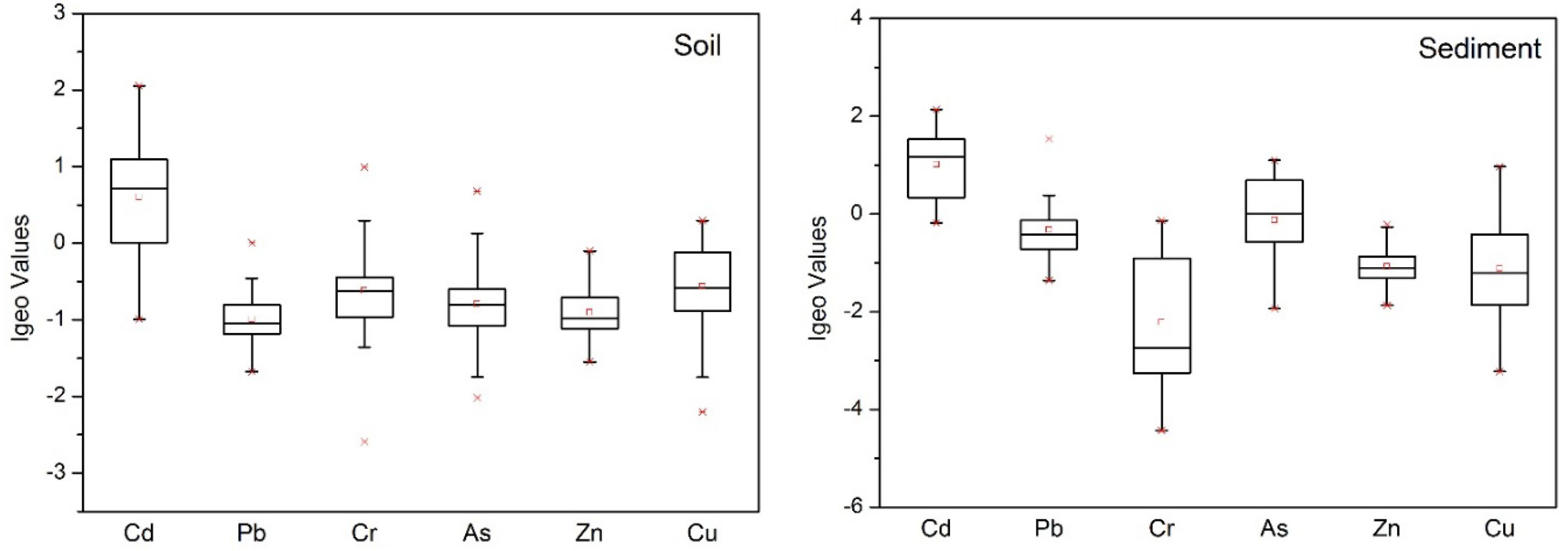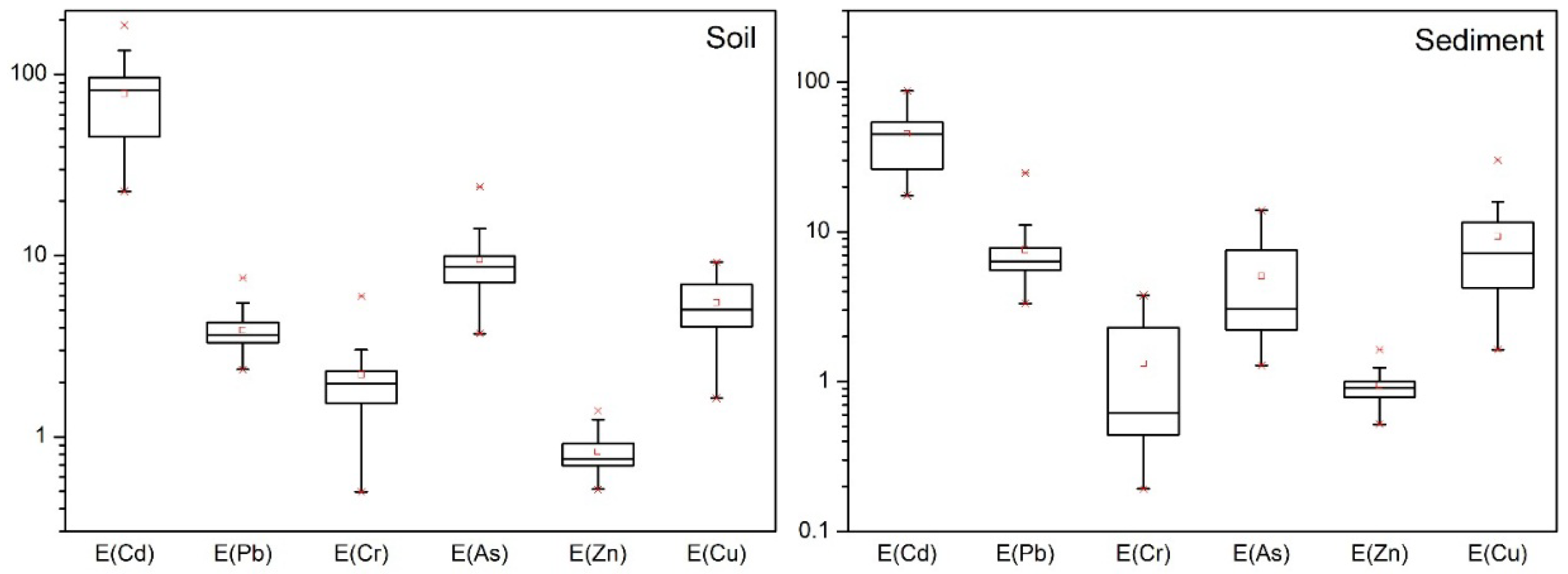Potentially Toxic Element Pollution Levels and Risk Assessment of Soils and Sediments in the Upstream River, Miyun Reservoir, China
Abstract
1. Introduction
2. Materials and Methods
2.1. Study Area
2.2. Sampling and Analyses Methods
2.3. Statistical Analyses
2.4. Ecological Risk Assessment Method
2.5. Human Health Risk Assessment
3. Results
3.1. Potentically Toxic Element, Nitrogen, and Phosphorus Concentrations in Soil and Sediment Samples
3.2. Potentially Toxic Element Pollution Levels in the Soil and Sediment
3.3. Relationships between Potentially Toxic Elements, Total Phosphorus, and Total Nitrogen
3.4. Potential Ecological Risk
3.5. Human Health Risk Posed by Soils
4. Discussion
5. Conclusions
Author Contributions
Funding
Acknowledgments
Conflicts of Interest
References
- Lu, C.A.; Zhang, J.F.; Jiang, H.M.; Yang, J.C.; Zhang, J.T.; Wang, J.Z.; Shan, H.X. Assessment of soil contamination with Cd, Pb and Zn and source identification in the area around the Huludao zinc plant. J. Hazard. Mater. 2010, 182, 743–748. [Google Scholar] [CrossRef] [PubMed]
- Chen, H.; Teng, Y.; Lu, S.; Wang, Y.; Wang, J. Contamination features and health risk of soil heavy metals in China. Sci. Total. Environ. 2015, 512–513, 143–153. [Google Scholar] [CrossRef] [PubMed]
- Pan, L.B.; Ma, J.; Hu, Y.; Su, B.Y.; Fang, G.L.; Wang, Y.; Wang, Z.S.; Wang, L.; Xiang, B. Assessments of levels, potential ecological risk, and human health risk of heavy metals in the soils from a typical county in Shanxi Province, China. Environ. Sci. Pollut. R. 2016, 23, 19330–19340. [Google Scholar] [CrossRef] [PubMed]
- García-Ordiales, E.; Esbrí, J.M.; Covelli, S.; López-Berdonces, M.A.; Higueras, P.L.; Loredo, J. Heavy metal contamination in sediments of an artificial reservoir impacted by long-term mining activity in the Almadén mercury district (Spain). Environ. Sci. Pollut. Res. 2016, 23, 6024–6038. [Google Scholar] [CrossRef] [PubMed]
- Chowdhury, S.; Mazumder, M.A.; Alattas, O.; Husain, T. Heavy metals in drinking water: Occurrences, implications, and future needs in developing countries. Sci. Total Environ. 2016, 569–570, 476–488. [Google Scholar] [CrossRef] [PubMed]
- Xia, F.; Qu, L.; Qu, L.Y.; Wang, T.; Luo, L.L.; Chen, H.; Dahlgren, R.A.; Zhang, M.H.; Mei, K.; Huang, H. Distribution and source analysis of heavy metal pollutants in sediments of a rapid developing urban river system. Chemosphere 2018, 207, 218–228. [Google Scholar] [CrossRef] [PubMed]
- Zhu, Q.Q.; Wang, Z.L. Distribution and Sources of Heavy Metals in Sediments of Main River in China. Earth Environ. 2012, 40, 305–313. (In Chinese) [Google Scholar]
- Xiao, L.; Guan, D.S.; Peart, M.R.; Chen, Y.J.; Li, Q.Q.; Jun, D. The influence of bioavailable heavy metals and microbial parameters of soil on the metal accumulation in rice grain. Chemosphere 2017, 185, 868. [Google Scholar] [CrossRef] [PubMed]
- Fan, Y.; Liu, L.S.; Song, K.Y.; Zhang, L.C.; Qin, J.; Li, H.; Cheng, F.Q. Assessment of the Heavy Metal Pollution of Greenhouse Vegetable Land in Central and Southern Shanxi. J. Shanxi Univ. 2017, 1, 201–208. (In Chinese) [Google Scholar]
- Liu, H.; Xiong, Z.Q.; Jiang, X.L.; Liu, G.H.; Liu, W.Z. Heavy metal concentrations in riparian soils along the Han River, China: The importance of soil properties, topography and upland land use. Ecol. Eng. 2016, 97, 545–552. [Google Scholar] [CrossRef]
- Deng, Q.S.; Tang, X.; Cai, R.; Xu, H.Y.; Zhang, R.T.; Li, B.J.; Li, S.C.; Xu, H.; Wang, H. Research on microbial remediation of heavy metal contaminated soil. Exp. Tech. Manag. 2017, 10, 43–49. (In Chinese) [Google Scholar]
- Wu, Q.; Qi, J.; Xia, X. Long-term variations in sediment heavy metals of a reservoir with changing trophic states: Implications for the impact of climate change. Sci. Total Environ. 2017, 609, 242–250. [Google Scholar] [CrossRef] [PubMed]
- Niu, L.; Yang, F.; Xu, C.; Yang, H.; Liu, W. Status of metal accumulation in farmland soils across China: From distribution to risk assessment. Environ. Pollut. 2013, 176, 55–62. [Google Scholar] [CrossRef] [PubMed]
- Yang, L. The Sources, Present Situation, Characteristics and Treatment Techniques of Soil Heavy Metal Pollution in China. China Res. Compreh. Utiliz. 2018, 2, 157–159. (In Chinese) [Google Scholar]
- Marquez, J.E.; Pourret, O.; Faucon, M.P.; Wever, S.; Hoàng, T.B.H.; Martinez, R.E. Effect of Cadmium, Copper and Lead on the Growth of Rice in the Coal Mining Region of Quang Ninh, Cam-Pha (Vietnam). Sustainability 2018, 10, 1758. [Google Scholar] [CrossRef]
- Nguyen, T.T.H.; Zhang, W.G.; Li, Z.; Li, J.; Li, J.; Ge, C.; Liu, J.Y.; Bai, X.X.; Feng, H.; Yu, L.Z. Assessment of heavy metal pollution in Red River surface sediments, Vietnam. Mar. Pollut. Bull. 2016, 113, 513. [Google Scholar] [CrossRef] [PubMed]
- David, C.A.; Fernando, F.F.H.; Gary, S.B.; Sadikshya, R.D.; Rebecca, T.C.; Francisco, N.S.; Paulo, F.F. Microbial community and heavy metals content in soils along the Curu River in Ceará, Brazil. Geoder. Region. 2018, 14, e00173. [Google Scholar]
- Inboonchuay, T.; Suddhiprakarn, A.; Kheoruenromne, I.; Anusontpornperm, S.; Gilkes, R.J. Amounts and associations of heavy metals in paddy soils of the Khorat Basin, Thailand. Geoder. Region. 2016, 7, 120–131. [Google Scholar] [CrossRef]
- Dean, J.R.; Elom, N.I.; Entwistle, J.A. Use of simulated epithelial lung fluid in assessing the human health risk of Pb in urban street dust. Sci. Total. Environ. 2017, 579, 387–395. [Google Scholar] [CrossRef] [PubMed]
- Lin, Y.; Zhuang, L.Z.; Ma, H.; Wu, L.X.; Huang, H.L.; Guo, H.H. Study on congenital cardiac anomalies induced by arsenic exposure before and during maternal pregnancy in fetal rats. J. Hyg. Res. 2016, 45, 93–97. [Google Scholar]
- Han, L.F.; Gao, B.; Lu, J.; Zhou, Y.; Xu, D.Y.; Gao, L.; Sun, K. Pollution characteristics and source identification of potentically toxic elements in riparian soils of Miyun Reservoir, China. Ecotoxicol. Environ. Saf. 2017, 144, 321. [Google Scholar] [CrossRef] [PubMed]
- Qin, F.; Li, Q.; Ji, H.B.; Feng, J.G.; Huang, X.X. Pollution assessment of heavy metals in soil around iron ore area in the upper reaches of Miyun Reservior. Environ. Sci. Tech. 2013, S2, 353–361. [Google Scholar]
- Gao, L.; Gao, B.; Zhou, Y.; Xu, D.Y.; Sun, K. Predicting remobilization characteristics of cobalt in riparian soils in the Miyun Reservoir prior to water retention. Ecol. Indic. 2017, 80, 196–203. [Google Scholar] [CrossRef]
- Pan, L.B.; Wang, S.Y.; Ma, J.; Fang, D. Gridded field observations of polycyclic aromatic hydrocarbons in soils from a typical county in Shanxi Province, China. Arch. Environ. Contam. Toxicol. 2015, 68, 323–329. [Google Scholar] [CrossRef] [PubMed]
- USEPA. Method 3050B: Acid Digestion of Sediments, Sludges and Soils; USEPA: Washington, DC, USA, 1996.
- USEPA. Method 6010C: Inductively Coupled Plasma Atomic Emission Spectrometry; USEPA: Washington, DC, USA, 1996.
- Sutherland, R.A. Bed sediment-associated potentically toxic elements in an urban stream, Oahu, Hawaii. Environ. Geol. 2000, 39, 611–627. [Google Scholar] [CrossRef]
- Müller, G. Index of geoaccumulation in sediments of the Rhine River. Geo. J. 1969, 2, 108–118. [Google Scholar]
- Solgi, E.; Esmailisari, A.; Riyahibakhtiari, A.; Hadipour, M. Soil contamination of metals in the three industrial estates, Arak, Iran. B Environ. Contam. Tox. 2012, 88, 634–638. [Google Scholar] [CrossRef] [PubMed]
- Hakanson, L. An ecological risk index for aquatic pollution control, a sedimentological approach. Water Res. 1980, 14, 975–1001. [Google Scholar] [CrossRef]
- Wang, H.; Lu, S. Spatial distribution, source identification and affecting factors of heavy metals contamination in urban-suburban soils of Lishui city, China. Environ. Earth Sci. 2011, 64, 1921–1929. [Google Scholar] [CrossRef]
- USEPA. Exposure Factors Handbook, Volume1: General Factors; U.S. Environmental Protection Agency, Office of Research and Development: Washington, DC, USA, 1997.
- Fryer, M.; Collins, C.D.; Ferrier, H.; Colvile, R.N.; Nieuwenhuijsen, M.J. Human exposure modeling for chemical risk assessment: A review of current approaches and research and policy implications. Environ. Sci. Policy 2006, 9, 261–274. [Google Scholar] [CrossRef]
- USEPA. Supplemental Guidance for Developing Soil Screening Levels for Superfund Sites; U.S. Environmental Protection Agency, Office of Emergency and Remedial Response: Washington, DC, USA, 2002.
- USEPA. Risk Assessment Guidance for Superfund; USEPA: Washington, DC, USA, 2011; Volume I.
- USEPA. Risk Assessment Guidance for Superfund; Volume 1: Human Health Evaluation Manual (Part A); U.S. Environmental Protection Agency, Office of Emergency and Remedial Response: Washington, DC, USA, 1989.
- CEPA (Chinese Environmental Protection Administration). Environmental Quality Standard for Soils; GB 15618-1995; CEPA: Beijing, China, 1995. [Google Scholar]
- Ferreira, B.L.; Miguel, E.D. Geochemistry and risk assessment of street dust in Luanda, Angola: A tropical urban environment. Atmos. Environ. 2005, 39, 4501–4512. [Google Scholar] [CrossRef]
- Young, S.R.; Black, A.S.; Conyers, M.K. Nitrogen mineralisation and nitrification in acidic subsurface layers of soil. In Plant-Soil Interactions at Low pH: Principles and Management; Springer: Dordrecht, The Netherlands, 1995. [Google Scholar]
- Breteler, H.; Smit, A.L. Effect of ammonium nutrition on uptake and metabolism of nit rate in wheat. Neth. J. Agric. Sci. 1974, 82, 587–592. [Google Scholar]
- Machado, W.; Sanders, C.J.; Santos, I.R.; Sanders, L.M.; Silva-Filho, E.V.; Luiz-Silva, W. Mercury dilution by autochthonous organic matter in a fertilized mangrove wetland. Environ. Pollut. 2016, 213, 30–35. [Google Scholar] [CrossRef] [PubMed]
- Li, R.; Chai, M.; Qiu, G.Y. Distribution, fraction, and ecological assessment of heavy metals in sediment-plant system in mangrove forest. South China Sea. PLoS ONE 2016, 11, e0147308. [Google Scholar] [CrossRef] [PubMed]
- Ning, L.; Yuan, K.; Pan, W.J.; Zeng, L.X.; Zhang, Q.Y.; Luo, J.W. Concentration and transportation of heavy metals in vegetables and risk assessment of human exposure to bioaccessible heavy metals in soil near a waste-incinerator site, South China. Sci. Total. Environ. 2015, 521–522, 144–151. [Google Scholar]
- Chabukdhara, M.; Nema, A. Heavy metals assessment in urban soil around industrial clusters in Ghaziabad. India: Probabilistic health risk approach. Ecotoxicol. Environ. Saf. 2013, 87, 57–64. [Google Scholar] [CrossRef] [PubMed]
- Song, Z.X.; Shana, B.Q.; Tang, W.Z.; Zhang, C. Will heavy metals in the soils of newly submerged areas threaten the water quality of Danjiangkou Reservoir, China? Ecotoxicol. Environ. Saf. 2017, 144, 380–386. [Google Scholar] [CrossRef] [PubMed]
- Zhang, G.L.; Bai, J.H.; Zhao, Q.Q.; Lu, Q.Q.; Jia, J.; Wen, X.J. Heavy metals in wetland soils along a wetland-forming chronosequence in the Yellow River Delta of China: Levels, sources and toxic risks. Ecol. Indic. 2016, 69, 331–339. [Google Scholar] [CrossRef]
- Zhang, Z.Y.; Ying, L.J.; Mamat, Z.; Fu, Y.Q. Sources identification and pollution evaluation of heavy metals in the surface sediments of Bortala River, Northwest China. Ecotox. Environ. Saf. 2016, 126, 94–101. [Google Scholar] [CrossRef] [PubMed]
- Zhu, L.; Liu, J.W.; Xu, S.G.; Xie, Z.G. Deposition behavior, risk assessment and source identification of heavy metals in reservoir sediments of Northeast China. Ecotoxicol. Environ. Saf. 2017, 142, 454–463. [Google Scholar] [CrossRef] [PubMed]
- Qiao, M.M.; Ji, H.B.; Zhu, X.F.; Chen, Y. Fraction distribution and risk assessment of heavy metals in sediments of inflow rivers of Miyun Reservior. Acta Sci. Circumstantiae 2013, 33, 3324–3333. (In Chinese) [Google Scholar]
- Zhang, G.L.; Bai, J.H.; Xiao, R.; Zhao, Q.Q.; Jia, J.; Cui, B.S.; Liu, X.H. Heavy metal fractions and ecological risk assessment in sediments from urban, rural and reclamation-affected rivers of the Pearl River Estuary, China. Chemosphere 2017, 184, 278–288. [Google Scholar] [CrossRef] [PubMed]
- Tang, Z.W.; Zhang, L.Z.; Huang, Q.F.; Yang, Y.F.; Nie, Z.Q.; Cheng, J.L.; Yang, J.; Wang, Y.W.; Chai, M. Contamination and risk of heavy metals in soils and sediments from a typical plastic waste recycling area in North China. Ecotoxicol. Environ. Saf. 2015, 122, 343–351. [Google Scholar] [CrossRef] [PubMed]
- Gunawardena, J.; Egodawatta, P.; Ayoko, G.A.; Goonetilleke, A. Atmospheric deposition as a source of heavy metals in urban stormwater. Atmos. Environ. 2013, 68, 235–242. [Google Scholar] [CrossRef]
- Cao, S.Z.; Duan, X.L.; Zhao, X.G.; Chen, Y.T.; Wang, B.B.; Sun, C.Y.; Zheng, B.H.; Wei, F.S. Health risks of children’s cumulative and aggregative exposure to metals and metalloids in a typical urban environment in China. Chemosphere 2016, 147, 404–411. [Google Scholar] [CrossRef] [PubMed]
- Guo, X.Y.; Luo, L.; Ma, Y.B.; Zhang, S.Z. Sorption of Polycyclic Aromatic Hydrocarbons Particulate Organic Matters. J. Hazard Mater. 2010, 173, 130–136. [Google Scholar] [CrossRef] [PubMed]
- Di Bonito, M.; Lofts, S.; Groenenberg, J.E. Chapter 11—Models of Geochemical Speciation: Structure and Applications. Environ. Geochem. 2018, 237–305. [Google Scholar] [CrossRef]




| EF Values | EF ≤ 1 | 1 < EF < 2 | 2 ≤ EF < 5 | 5 ≤ EF < 20 | 20 ≤ EF < 40 | EF ≥ 40 |
|---|---|---|---|---|---|---|
| Categories | no | slight | moderate | significant | strong | extremely strong |
| Igeo Values | Igeo ≤ 0 | 0 ≤ Igeo ≤ 1 | 1 ≤ Igeo ≤ 2 | 2 ≤ Igeo ≤ 3 | 3 ≤ Igeo ≤ 4 | 4 ≤ Igeo ≤ 5 | Igeo ≥ 5 |
|---|---|---|---|---|---|---|---|
| Categories | unpolluted | unpolluted to moderately | moderately | moderately to heavily | heavily | heavily to extremely | extremely |
| Elements | GIABS a | Oral RFD b,c (mg·kg−1·day−1) | Dermal RFD b,c (mg·kg−1·day−1) | Inhalation RFD (mg·kg−1·day−1) | Oral SF (mg·kg−1·day−1) | Dermal SF b,c (mg·kg−1·day−1) | Inhalation SF b,c (mg·kg−1·day−1) |
|---|---|---|---|---|---|---|---|
| Pb | 1 | 1.40 × 10−3 | 5.24 × 10−4 | 5.71 × 10−5 | NA | NA | NA |
| Cd | 0.25 | 3.00 × 10−3 | 3.00 × 10−3 | 5.71 × 10−5 | 5.01 × 10−1 | 2.00 × 101 | NA |
| Cr | 0.25 | NA | NA | NA | NA | NA | 4.20 × 101 |
| Cu | 0.04 | 2.00 × 10−2 | 5.40 × 10−3 | NA | 1.70 × 100 | 4.25 × 101 | NA |
| Zn | 1 | 4.00 × 10−2 | 1.20 × 10−2 | NA | NA | NA | NA |
| Ni | 1 | NA | NA | 3.00 × 10−1 | NA | NA | 8.40 × 101 |
| As | 1 | NA | NA | NA | 1.50 × 100 | 3.66 × 100 | 1.51 × 101 |
| Hg | 0.07 | 3.00 × 10−4 | 2.13 × 10−5 | 8.57 × 10−5 | NA | NA | NA |
| Metals | Soil | Sediment | BK | ||||||||
|---|---|---|---|---|---|---|---|---|---|---|---|
| N | Minimum | Maximum | Mean | SD | N | Minimum | Maximum | Mean | SD | ||
| Cd | 33 | 0.04 | 0.33 | 0.14 | 0.06 | 18 | 0.07 | 0.35 | 0.18 | 0.08 | 0.053 |
| Pb | 33 | 11.60 | 37.19 | 19.14 | 4.95 | 18 | 14.42 | 107.25 | 33.01 | 20.46 | 24.7 |
| Cr | 33 | 16.59 | 199.25 | 72.44 | 37.42 | 18 | 4.63 | 91.01 | 31.53 | 26.50 | 66.7 |
| As | 33 | 3.48 | 22.55 | 8.94 | 4.25 | 18 | 3.69 | 30.24 | 15.14 | 8.07 | 9.4 |
| Cu | 33 | 49.82 | 135.72 | 80.46 | 22.28 | 18 | 39.79 | 125.53 | 72.34 | 23.17 | 97.2 |
| Zn | 33 | 7.52 | 42.54 | 25.21 | 9.02 | 18 | 3.70 | 67.96 | 21.01 | 16.96 | 23.1 |
| TN | 33 | 437.00 | 1620.00 | 850.39 | 271.36 | 17 | 119.00 | 5620.00 | 1741.53 | 2024.35 | - |
| TP | 33 | 218.00 | 3040.00 | 1165.55 | 551.50 | 17 | 334.00 | 4380.00 | 1527.82 | 994.13 | - |
| Metals | Cd | Pb | Cr | As | Zn | Cu | TP | TN | |
|---|---|---|---|---|---|---|---|---|---|
| Soil | Cd | 1.000 | 0.535 * | −0.185 | 0.583 * | 0.324 | 0.038 | 0.140 | 0.621 * |
| Pb | 1.000 | −0.504 | 0.495 | 0.234 | −0.079 | 0.148 | 0.727 ** | ||
| Cr | 1.000 | −0.175 | 0.343 | 0.468 | 0.189 | −0.057 | |||
| As | 1.000 | 0.286 | 0.243 | −0.018 | 0.311 | ||||
| Zn | 1.000 | 0.836 ** | 0.146 | 0.411 | |||||
| Cu | 1.000 | −0.118 | 0.221 | ||||||
| TN | 1.000 | 0.129 | |||||||
| TP | 1.000 | ||||||||
| Sediment | Cd | 1.000 | 0.931 ** | 0.083 | 0.411 | 0.011 | 0.233 | 0.767 ** | 0.028 |
| Pb | 1.000 | 0.036 | 0.323 | −0.009 | 0.205 | 0.767 ** | 0.106 | ||
| Cr | 1.000 | 0.009 | 0.375 | 0.536 * | −0.112 | −0.020 | |||
| As | 1.000 | −0.046 | −0.011 | −0.038 | −0.094 | ||||
| Zn | 1.000 | 0.552 * | 0.154 | 0.482 * | |||||
| Cu | 1.000 | 0.209 | 0.319 | ||||||
| TN | 1.000 | 0.337 |
| Metal | Chao River | Baimaguan River | ||
|---|---|---|---|---|
| Adults | Children | Adults | Children | |
| Cd | 2.86 × 10−4 | 1.74 × 10−3 | 1.62 × 10−4 | 9.86 × 10−4 |
| Pb | 1.96 × 10−2 | 1.36 × 10−1 | 1.87 × 10−2 | 1.29 × 10−1 |
| Zn | 2.47 × 10−3 | 1.71 × 10−2 | 3.06 × 10−3 | 2.12 × 10−2 |
| Cr | 3.21 × 10−5 | 4.28 × 10−5 | 1.90 × 10−5 | 2.53 × 10−5 |
| As | 7.69 × 10−6 | 1.07 × 10−5 | 8.18 × 10−6 | 1.14 × 10−5 |
| Cu | 1.36 × 10−4 | 9.48 × 10−4 | 1.04 × 10−4 | 7.21 × 10−4 |
© 2018 by the authors. Licensee MDPI, Basel, Switzerland. This article is an open access article distributed under the terms and conditions of the Creative Commons Attribution (CC BY) license (http://creativecommons.org/licenses/by/4.0/).
Share and Cite
Pan, L.; Fang, G.; Wang, Y.; Wang, L.; Su, B.; Li, D.; Xiang, B. Potentially Toxic Element Pollution Levels and Risk Assessment of Soils and Sediments in the Upstream River, Miyun Reservoir, China. Int. J. Environ. Res. Public Health 2018, 15, 2364. https://doi.org/10.3390/ijerph15112364
Pan L, Fang G, Wang Y, Wang L, Su B, Li D, Xiang B. Potentially Toxic Element Pollution Levels and Risk Assessment of Soils and Sediments in the Upstream River, Miyun Reservoir, China. International Journal of Environmental Research and Public Health. 2018; 15(11):2364. https://doi.org/10.3390/ijerph15112364
Chicago/Turabian StylePan, Libo, Guangling Fang, Yue Wang, Lei Wang, Benying Su, Dan Li, and Bao Xiang. 2018. "Potentially Toxic Element Pollution Levels and Risk Assessment of Soils and Sediments in the Upstream River, Miyun Reservoir, China" International Journal of Environmental Research and Public Health 15, no. 11: 2364. https://doi.org/10.3390/ijerph15112364
APA StylePan, L., Fang, G., Wang, Y., Wang, L., Su, B., Li, D., & Xiang, B. (2018). Potentially Toxic Element Pollution Levels and Risk Assessment of Soils and Sediments in the Upstream River, Miyun Reservoir, China. International Journal of Environmental Research and Public Health, 15(11), 2364. https://doi.org/10.3390/ijerph15112364




